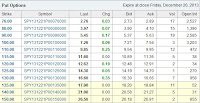To begin to understand these instruments, go to Yahoo! Finance, put in "SPY" in the quote box, and click "options" in the right hand column. SPY is an exchange traded fund (ETF) indexed to the S&P 500. You can either buy the ETF outright, or you can buy options that allow you to buy or sell the ETF over a given period.
You come to this: note the price of SPY circled toward the upper right and the circled 2013.
| Source: Yahoo finance |
Why we would care about these instruments? Let's consider a scenario.
Suppose you read the opening article this week in BusinessWeek. It talks about food prices rising in emerging economies, social unrest, inflation on the verge of picking up. Further in the magazine, you read about the impact of rising interest rates on the federal deficit. And you begin to think, "Holy cow, we're going down the same road as Greece." You begin to wonder how you can protect the gains you have in your stock portfolio and, at the same time, you don't want to lighten up just yet because you feel there may be some upside left.
Stay with me. You've clicked on "2013" and you've come to a list of options. Heading the list is calls - these are what investors buy if they believe prices are headed higher. We're interested in protection against falling prices, so we scroll down to the puts.
We come to
 |
| Source: Yahoo finance |
Hopefully, you can see that, for a relatively small amount, LEAPS provide portfolio insurance. If the market collapses and SPY goes to $80, say, the contract would have a value of at least $2,000.
 Two really good examples of how they have paid off big-time are available.
Two really good examples of how they have paid off big-time are available. The second example was briefly mentioned in a previous post about two investors who foresaw the housing market crisis and used LEAP options to take a small Schwab account to multi-millions. This story was told in The Big Short by Michael Lewis (#9 on New York Times best seller list).

How would a DIY investor get to understand these instruments? First of all, I want to make clear that I am not recommending options but instead am introducing them as an educational message. They very well could be a tool some DIY investors would want in their tool boxes, after study and consultation with an advisor.
In this spirit, I would recommend an interested investor buy contracts on 100 shares - of a stock or index. It can be a call or a put, for that matter. By actually buying an option and following it, the DIY investor will quickly learn how the time value of money comes into play, the varying risk premium depending on recent volatility, etc.
As a further caveat - it can seem very easy to make money with these instruments when you are on the right side of the market because of the leverage factor. As a result, it is easy to get carried away. Caveat emptor!
No comments:
Post a Comment